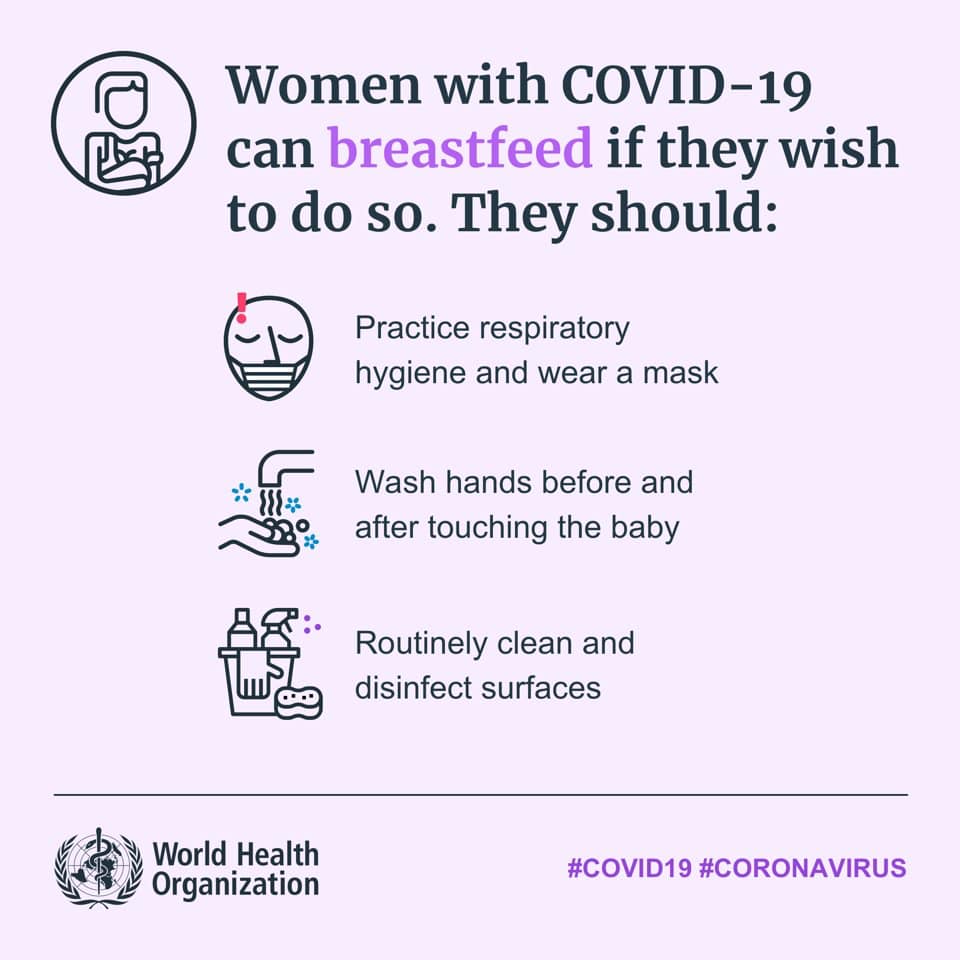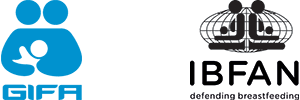updated March 6, 2022
May 2021
Swiss Ministery of Health considers that vaccination Covid-19 is possible for pregnant and breastfeeding women as of May 28, 2021.
Monthly update – Specific repository (bibliography) only on COVID-19, Breastfeeding, Infant Feeding, and Breast Milk with regular updates (last update : 2021 June 10). PDF can be downloaded here Johns Hopkins – Center for Humanitarian Health.
Breastfeeding and Covid-19 vaccine – https://pubmed.ncbi.nlm.nih.gov/33419782/ Rimmer et al, BMJ study from January 8, 2021. Covid-19: Breastfeeding women can have vaccine after guidance turnaround
Covid-19, lait maternel et système immunitaire, études récentes (voir la page GIFA “Immunologie” ici)
- Didikoglu A et al. Early life factors and COVID-19 infection in England: A prospective analysis of UK Biobank participants (Feb 2021) https://doi.org/10.1016/j.earlhumdev.2021.105326 “The odds of contracting COVID-19 were 12% lower among respondents who were breastfed when they were babies.”
- Pace et al COVID-19 and human milk: SARS-CoV-2, antibodies, and neutralizing capacity (2020, Oct 21) https://www.medrxiv.org/content/10.1101/2020.09.16.20196071v1
- Tong et al, Mother’s Milk May Inhibit COVID-19 (2020, Sept 29) https://www.medscape.com/viewarticle/938228?nlid=137631_2046&src=WNL_mdplsnews_201002_mscpedit_peds&uac=104320SJ&spon=9&impID=2599391&faf=1 Mother’s milk could help treat or prevent the coronavirus.
- Van Keulen et al, Breastmilk; a source of SARS-CoV-2 specific IgA antibodieshttps://www.medrxiv.org/content/10.1101/2020.08.18.20176743v1 The research so far seems to back this up. Scientists at Amsterdam University say they have found multiple lines of evidence on the presence of a variety of antibodies that are effective against SARS-CoV-2 in the breastmilk of corona-affected women, with no such antibodies present in the controls.
GIFA document (June 29, 2020) research of SARS-CoV-2 virus in breast-milk
Bilingual page English-French / Page bilingue français / anglais
Breastfeeding in the COVID-19 context – Corona virus
Allaitement dans le contexte COVID-19 – Corona virus
In brief
Transmission of active COVID-19 (virus that can cause infection) through breast milk and breastfeeding has not been detected to date. There is no reason to avoid or stop breastfeeding.
Recommendations on May 28, 2020 are to initiate or maintain breastfeeding and, if mother-baby separation is necessary, to give pumped breast milk.
WHO / OMS Film on Breastfeeding and Covid-19 – Comment allaiter si maman est Covid-19 positive ? Voir les bons gestes
En bref
Le virus responsable de la COVID-19 n’est pas détecté dans le lait maternel. À ce jour, aucune transmission du virus de la COVID-19 par le lait maternel ou l’allaitement n’a été observée. Il n’y a aucune raison d’éviter ou d’arrêter l’allaitement.
Les recommandations actuelles du 28 mai préconisent d’initier ou de maintenir l’allaitement et, si la séparation mère-enfant s’avère nécessaire, de donner du lait maternel tiré.
References for Health Care Providers / pour les professionnels de la santé
Information for parents / pour les parents voir ici

Information in English on Covid-19
- WHO Q & A on COVID-19, pregnancy, childbirth and breastfeeding
- La Leche League International (en français et 10 autres langues) https://www.llli.org/coronavirus10/
- Royal College of Obstetricians & Gynaecologists (UK, April 3, 2020) Information for pregnant women and their families
WHO Frequently asked Questions: Breastfeeding and Covid-19 (April 28, 2020) 5 pages for Health care workers
May 8, 2020 : Salvatori et al on two mother-baby dyads show no transmission through breastfeeding. “We confirm that SARS-CoV-2 seems to spare breast milk and horizontal transmission from mother to neonate could occur through respiratory droplets rather than through milk.” May 8, 2020 Managing COVID-19-Positive Maternal–Infant Dyads: An Italian Experience https://doi.org/10.1089/bfm.2020.0095
Baby Milk Action Network – List on Covid-19 and Breastfeeding News http://www.babymilkaction.org/archives/24184
WHO Position paper (8 avril 2020) “Breastmilk is the best source of nutrition for infants, including infants whose mothers have confirmed or suspected coronavirus infection. As long as an infected mother takes appropriate precautions—outlined in this paper—she can breastfeed her baby. Breastmilk contains antibodies and other immunological benefits that can help protect against respiratory diseases. A growing body of evidence supports the importance of breastfeeding for a child’s growth, development, and health, as well as for helping them avoid obesity and noncommunicable diseases later in life.”
UNICEF (IYCF 30 mars 2020) Infant & Young Child Feeding in the context of Covid-19 (9 pages)
WHO Interim guidance (13 mars 2020) (21 pages) – see pages 13-14 https://www.who.int/publications-detail/clinical-management-of-severe-acute-respiratory-infection-when-novel-coronavirus-(ncov)-infection-is-suspected
Royal College of Obstetricians & Gynaecologists (UK, April 9, 2020) https://www.rcog.org.uk/en/guidelines-research-services/guidelines/coronavirus-pregnancy/
Informations en français sur Covid-19
Actuellement, les données ne montrent pas de risques de transmission du virus actif SARS-CoV-2 par le lait maternel. L’infection maternelle à Covid-19 ne constitue pas une contre- indication à l’allaitement. L’allaitement est possible et encouragé au vu de ses effets généraux bénéfiques sur la santé de la mère et de l’enfant, selon les recommandations de nombreux experts et sociétés savantes internationales et nationales (OMS, UNICEF, CDC, SSP, OFSP/Swissnoso/PIGS, SGGG).
- OMS Questions – réponses sur Covid-19 et allaitement (7 mai 2020)
- OMS Note de synthèse Position paper (8 avril 2020)
- OMS Lignes directrices provisoires (13 mars 2020), pages 13-14
- CHUV Lausanne (en 7 langues) Grossesse, accouchement, allaitement et Covid-19
- Un film sur la grossesse, la naissance et COVID-19 par le Prof. David Baud, CHUV Lausanne
- La Leche League France Allaitement-et-coronavirus
- Fondation Naitre et grandir (Québec)
https://naitreetgrandir.com/fr/nouvelles/2020/03/18/20200319-allaitement-temps-coronavirus/
OMS Note de synthèse Position paper (8 avril 2020). Le lait maternel constitue la meilleure source de nutrition pour les nourrissons, y compris pour ceux dont la mère est un cas suspecté ou avéré d’infection à coronavirus. Tant que la mère prend les précautions nécessaires, soulignées ci-après, elle peut donner le sein à son enfant. Le lait maternel contient des anticorps et présente d’autres vertus immunologiques qui protègent le nourrisson des maladies respiratoires. De plus en plus de données probantes témoignent de l’importance de l’allaitement qui favorise la croissance, le développement et la santé de l’enfant et qui contribue à prévenir l’obésité et le développement de maladies non transmissibles à un âge plus avancé.
OMS Lignes directrices provisoires (13 mars 2020) (21 pages) see pages 13-14 https://www.who.int/fr/publications-detail/clinical-management-of-severe-acute-respiratory-infection-when-novel-coronavirus-(ncov)-infection-is-suspected
SSGO Société Suisse de Gynécologie et d’Obstétrique (14 avril 2020) https://www.sggg.ch/fr/nouvelles/detail/1/infection-a-coronavirus-covid-19-et-grossesse/
- IBFAN Latin America has a Breastfeeding and Covid-19 Facebook group with important guidelines and tools, country policies, IBFAN statements, lessons sharing. You can join and invite others: https://www.facebook.com/groups/2681030788691515/?ref=share
CHUV Lausanne Actuellement, les données bien que limitées, ne montrent pas de risques de transmission du virus actif SARS- CoV-2/Covid-19 par le lait maternel. L’infection maternelle à Covid-19 ne constitue pas une contre- indication à l’allaitement, qui est possible et encouragé au vu de ses effets généraux bénéfiques sur la santé de la mère et de l’enfant, selon les recommandations de nombreux experts et sociétés savantes internationales et nationales (OMS, UNICEF, CDC, SSP, OFSP/Swissnoso/PIGS, SGGG). Informations générales : https://www.chuv.ch/fr/dfme/dfme-home/femme-mere/grossesse-accouchement/suivi-de-grossesse-et-covid-19/
SFN Société Française de Néonatalogie (16 mars 2020) : COVID-19 – Propositions de la SFN et de la SFP concernant les nouveau-nés dans le contexte d’épidémie – v2 (4 pages) https://www.societe-francaise-neonatalogie.fr/alertes-et-avis-tous
Académie Nationale de Médecine (France, 30 mars 2020), Communiqué Covid-19, grossesse et accouchement (2 pages)
Pour des questions relatives aux médicaments et allaitement dans des situations complexes, on peut également consulter le STIS (Swiss Teratogen Information Service) http://www.swisstis.ch/
Informaciones en español
Grupo de Trabajo Internacional Voluntario de Expertos en Lactancia Materna https://paso10.org/
IBFAN Latin America has a Breastfeeding and Covid-19 Facebook group with important guidelines and tools, country policies, IBFAN statements, lessons sharing. You can join and invite others: https://www.facebook.com/groups/2681030788691515/?ref=share
Auf deutsch
ELACTA European Lactation Consultant Association gibt gute Information zur Studie von Gross et al. (Lancet, 21. Mai 2020): ZITAT Ein am 21. Mai 2020 im Lancet veröffentlichter → Fallbericht über zwei Frauen, die an an einer Klinik in Baden-Württemberg* entbunden hatten und das Zimmer teilten, hat internationale Aufmerksamkeit erregt. Beide Mütter und Kinder hatten sich infiziert, jedoch wurden nur bei einer der beiden Frauen RNA-Bruchstücke von SARS-CoV2 in ihrer Muttermilch gefunden.
Dieser Nachweis alleine ist jedoch kein Grund, die derzeit bestehenden Empfehlungen zu verändern:
– RNA-Bruchstücke sind nicht gleichbedeutend mit vollständig aktiven Viren
– Es ist nicht vollständig auszuschließen, dass diese Bruchstücke durch Verunreinigung in die Muttermilchproben gelangten
– Es ist nicht nachgewiesen, dass der betroffene Säugling sich über die Muttermilch infizierte und nicht stattdessen über Tröpfchen-/ Schmierinfektion durch die eigene Mutter oder die im gleichen Raum liegende infektiöse andere Mutter
– Beim betroffenen Säugling, der Symptome entwickelte, wurde neben der COVID-19-Infektion auch eine RSV-Infektion festgestellt
– Der Verlauf der Erkrankung war bei bei beiden beteiligten Müttern und einem Kind leicht. Das zweite Kind, das auch von der RSV-Infektion betroffen war und bei dessen Mutter die Muttermilch positiv getestet wurde, musste zeitweise beatmet werden.
Sicher wird die Wissenschaft in den kommenden Monaten weitere Erkenntnisse zur besonderen Situation von Schwangeren und Stillenden gewinnen. Dies wird bei Bedarf zu einer Anpassung der geltenden Empfehlungen führen. Derzeit sind die untenstehenden Empfehlungen unverändert. ENDE ZITAT
SGGG Schweizerische Gesellschaft für Gynäkologie und Geburtshilfe (14 avril 2020) https://www.sggg.ch/news/detail/1/coronavirusinfektion-covid-19-und-schwangerschaft/
DGGG Deutsche Gesellschaft für Gynäkologie und Geburtshilfe, German Society for Gynecology and Obstetrics Webseite
Useful information
The difference between SARS-CoV-2 and COVID-19
1) SARS-CoV-2 = name of the virus. The virus was named by the International Committee on Taxonomy of Viruses (ICTV) as “Severe Acute Respiratory Syndrome Coronavirus 2,” abbreviated as SARS-CoV-2.
2) COVID-19 = name of the disease. The SARS-CoV-2 virus causes “Coronavirus Disease 2019,” which was named by the World Health Organization and abbreviated as COVID-19.
#coronavirus #covid19 #OMS #IBCLC #UNICEF #LaLecheLeagueInternational #IBFAN #WABA #ILCA # TaskForcePaso10 #LactanciaEnEmergencia
